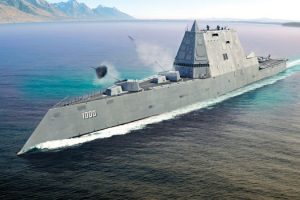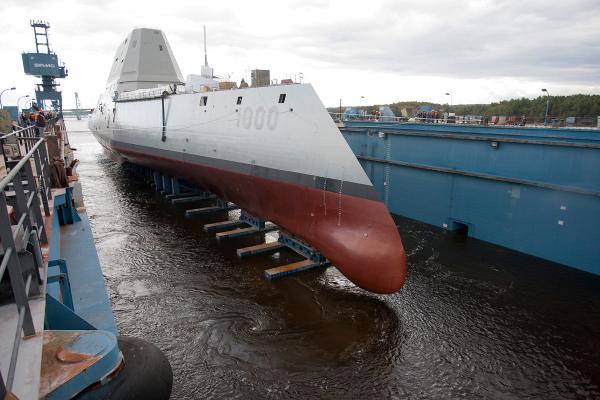When the Navy needs to surprise and overwhelm an inland enemy, it can send in its new Zumwalt-class destroyer.

The Zumwalt-Class Destroyer Nick Kaloterakis
When the USS Zumwalt rolls out of dry dock at Bath Iron Works in Maine next year, the Navy’s newest warship will be 100 feet longer than the destroyers currently serving around the globe—and nearly twice as massive—yet it will have a radar signature 50 times smaller and will carry half the crew. Packed bow to stern with state-of-the-art radar, stealth, weapons, and propulsion systems, the USS Zumwalt, which will be operational in mid-2016, will be the most technologically sophisticated warship ever to hit the water.
A complement to Arleigh Burke–class destroyers that currently protect the Navy’s prized aircraft carriers from aerial attacks, the Zumwalt-class destroyer is for laying waste to land. It can evade enemy detection; slip into the shallows along foreign coastlines; and deliver devastatingly accurate firepower hundreds of miles inland, supporting special operations ashore, clearing the way for amphibious troop landings, or knocking out air defenses. It’s a seaborne battering ram—a specialized piece of equipment for smashing in the enemy’s front door.
In the 1990s, the U.S. military carried out successful amphibious assaults in Somalia and elsewhere. But as coastal defenses around the world grew more advanced—not least those of Iraq, which would have been a serious threat to U.S. troops had they invaded Kuwait by sea during Operation Desert Storm—the Navy decided to build the Zumwalt.
Traditional destroyers create huge wakes and their hulls tend to light up radar dishes. By contrast, the angle of the Zumwalt‘s hull reduces its radar signature 50-fold (on radar it looks like a fishing boat) and slices through the water like a 600-foot harpoon, creating little wake and making it more difficult to see from both above and below. Though it rides low, the Zumwalt can operate in just 30 feet of water, scanning for airborne and underwater threats with planar-array radar and advanced sonar.

If geopolitical events call for securing nuclear facilities in an unraveling North Korea or Iran, the Zumwalt is the Navy’s surest way to arrive unannounced. From the shallows, the Zumwalt can then wipe out enemy defenses up to 72 miles away. Sailors don’t cram shells into the dual 155-millimeter guns nor do they clear the casings. The guns are controlled—point, click, boom—by a computer in the command center; they fire GPS-guided shells, considered by the Navy to be more like rockets than artillery because of their ability to adjust trajectory in flight. The ship also carries a battery of SM-2 antiaircraft missiles, surface-targeting Tomahawks, missile-destroying ESSM interceptors, and vertically launched ASROC antisubmarine torpedoes, all distributed among 80 missile cells that line the Zumwalt‘s hull. The location of the cells ensures that the missiles can’t all be disabled by a single enemy strike and serves as an extra layer of defense around the ship.
read more: http://www.popsci.com/technology/article/2012-08/ocean-power

